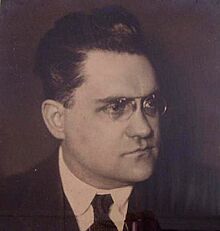Jan van Gilse facts for kids
Jan Pieter Hendrik van Gilse (born May 11, 1881 – died September 8, 1944) was a talented Dutch composer and conductor. He wrote many pieces, including five symphonies and an opera in Dutch called Thijl.
Contents
Jan van Gilse's Early Life and Music Studies
Jan van Gilse came from a family of religious leaders, but he showed a great talent for playing the piano and writing music from a young age. In 1897, he began studying at the Cologne conservatory. After his teacher passed away in 1902, he continued his studies in Berlin with Engelbert Humperdinck. From 1909 to 1911, he also studied music in Italy.
Jan van Gilse won important awards for his music. In 1901, he received the Beethoven-Haus Prize for his First Symphony. Later, in 1906, he won the Michael Beer Prize for his Third Symphony, which was called 'Erhebung' (meaning 'Elevation'). This symphony was written for a solo singer and an orchestra.
Becoming a Conductor and Challenges
Besides composing, Jan van Gilse quickly became interested in leading orchestras as a conductor. He started his conducting career at the Bremen Opera. After that, he worked in Munich and Amsterdam. When the First World War began, it became hard to travel, so he moved back to the Netherlands. From 1917 to 1922, he was the conductor for the Utrecht Municipal Orchestra.
In 1921, Jan van Gilse left his job as conductor after a disagreement with the orchestra's leaders. A music critic named Willem Pijper had been writing very harsh articles about him. Van Gilse asked that Pijper not be allowed to attend concerts, but his request was not handled quickly. Feeling disappointed, van Gilse resigned. The orchestra's board then refused to give him a special farewell concert.
Years later, Jan van Gilse wrote about his experiences in Utrecht in an autobiography. It was a very long book, almost 350,000 words! He was very honest in it, even about himself, so he wasn't sure if it would ever be published. However, the book was finally edited and released in 2003.
Jan van Gilse During World War II
During World War II, Jan van Gilse bravely joined the resistance movement against the German occupation of the Netherlands. Both of his sons were also resistance fighters, and they were sadly killed by the occupiers. Jan van Gilse himself passed away in the autumn of 1944, likely from pneumonia. To keep his hiding place a secret, he was buried in an unmarked grave outside the village of Oegstgeest.
Helping Musicians and Composers
Jan van Gilse was also a strong supporter of other musicians. From 1933 to 1937, he was the director of the Utrecht conservatory, a school for music. He also worked hard to protect the rights and interests of composers in the Netherlands. In 1911, he helped start the Society of Dutch Musicians (GENECO). Just one year later, he played a key role in creating the Dutch Bureau for Musical Copyrights (Buma), which helps composers get paid for their music.
Jan van Gilse's Musical Style and Legacy
Jan van Gilse's early music was influenced by German late romanticism, a style that focused on strong emotions and grand sounds. However, after about 1920, his music became more modern. His opera Thijl, written in 1940, is often seen as his greatest work. It's considered one of the most important operas in Dutch music history and shows his unique style. The German occupiers tried to destroy all of van Gilse's work during the war, but his friends and colleagues managed to save it.
Recently, more people have become interested in Jan van Gilse's music. This is partly thanks to the publication of his autobiography and a book about his life. A German music company called CPO has recorded his four completed symphonies. There are also plans to record his opera Thijl soon, all under the direction of conductor David Porcelijn.
Selected List of Works
- Symphonies:
- Symphony No. 1 in F major (1900–01; recorded)
- Symphony No. 2 in E♭ major (1902–1903; recorded)
- Symphony No. 3 in D minor, "Erhebung" for soprano and orchestra (1903; recorded)
- Symphony No. 4 in A major (1910–1915; recorded)
- Symphony No. 5 in D major (Fragment; 1922)
- Orchestral works:
- Concert Overture in C minor (1900; recorded)
- Variations on a St. Nicholas Song (1908; recorded)
- Three Dance Sketches for piano and small orchestra (1925–26; recorded as "Piano Concerto")
- Prologus brevis (1928)
- Praeludium to "Der Kreis des Lebens" (1928)
- Small Waltz (1936)
- Treurmuziek bij den dood van Uilenspiegel, from the opera Thijl (1940; recorded)
- Andante con moto (date uncertain, after 1935)
- Works for voice(s) & orchestra:
- Operas:
- Frau Helga von Stavern, opera on a text by Van Gilse, in German (1911–13)
- Thijl, opera after Charles de Coster's novel The heroic, jolly and notorious acts of Uilenspiegel and Lamme Goedzak in Flanders Country and elsewhere, on a libretto by Hendrik Lindt (1940; recorded)
- Chamber Pieces:
- Nonet, for oboe, clarinet, bassoon, horn, 2 violins, viola, cello and double bass (1916)
- String Quartet, an unfinished string quartet (1922)
- Trio for flute, violin and viola (1927)


